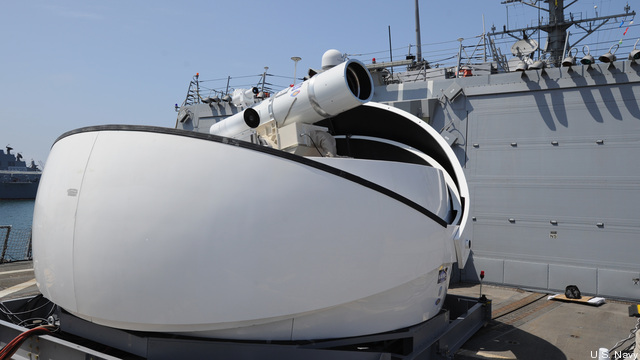Navy Will Send Prototype Laser Weapon To Persian Gulf: Adm. Greenert
Posted on
 NATIONAL HARBOR: The Navy will send a prototype laser weapon to the troubled Persian Gulf for a roughly year-long test deployment starting “less than a year from now,” the Chief of Naval Operations, Adm. Jonathan Greenert, announced today at the Navy League’s annual Sea-Air-Space conference.
NATIONAL HARBOR: The Navy will send a prototype laser weapon to the troubled Persian Gulf for a roughly year-long test deployment starting “less than a year from now,” the Chief of Naval Operations, Adm. Jonathan Greenert, announced today at the Navy League’s annual Sea-Air-Space conference.
The bad news is this isn’t some superweapon out of science fiction. The Navy’s Laser Weapon System (LaWS) is a fairly modest death ray that, for now, can only kill small boats and drones. Unlike the lasers of Ronald Reagan’s Star Wars dreams, nuclear missiles aren’t on the menu.
The good news is this isn’t science fiction. “We’re taking it out there to be an operational weapon,” said Rear Adm. Matthew Klunder, chief of the Office of Naval Research, said in a briefing after Adm. Greenert’s announcement.
Klunder claims the laser has scored 12 straight hits in 12 trials against flying targets, mostly firing from test sites on land but, in three cases, from the deck of an actual Navy warship, the destroyer USS Dewey. As early as this fall, the same prototype laser used in those tests will be installed on the USS Ponce, a former amphibious warfare ship converted to the Navy’s first Afloat Forward Staging Base. (Ponce’s large deck and copious cargo space, originally meant for transporting Marines, make it well-suited to host experiments in everything from firing lasers to clearing mines).
So what will the laser on the Ponce be good for in the real world of rising tensions with Iran? Because the user can dial the power up and down “like a rheostat,” Klunder said that on low settings the laser can serve as a non-lethal warning shot, warning suspicious ships and aircraft that the US has them in its sights and they’d better back off. Dialed higher, it might be able to dazzle and temporarily blind enemy personnel — though the Geneva Conventions condemns most blinding weapons, ironically preferring ones that kill outright.
At its highest settings, the laser should be able to counter Iran’s nascent force of unmanned aircraft and swarms of heavily armed but unarmored fast attack boats favored by the Iranian Revolutionary Guard Corps. But it won’t be able to kill tougher and faster targets, like supersonic anti-ship missiles — the kind that crippled the USS Stark in 1987 — and the ballistic missiles that carry nuclear weapons.
“Some day could it do missile defense? Perhaps; we’re not there yet,” Adm. Greenert said. “That’s really a function of power,” not the underlying technology.
And here’s the huge attraction of lasers for the US Navy. Current missile defense systems rely on firing one missile to shoot down another — and often the defending missile has to be more complex and most costly than the attacking missile it’s trying to stop. A Navy ship can only carry so many missiles and each one fired costs millions of dollars.
But with a laser or other “directed energy” weapon, you can keep on shooting as long as you have electrical power, any any combat ship in the fleet should have enough power. The cost of firing the prototype laser? According to Greenert and Klunder, it’s less than a dollar per shot.
Subscribe to our newsletter
Promotions, new products and sales. Directly to your inbox.
